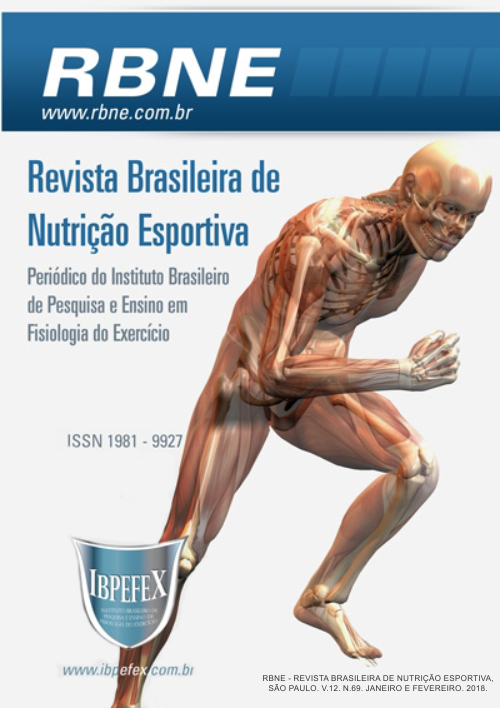Evaluation of the body composition of a futsasl professional team from the city of Pato Branco-PR
Abstract
Futsal is a sport characterized by intermittent exercises of varying intensity, this provides a caloric requirement superior to subjects not practicing physical exercises and that depending on the level of activity of the athlete, can represent an important daily energy expenditure. The aim of the present study was to evaluate the body composition of a professional futsal team in the city of Pato Branco-PR. The sample consisted of 16 male athletes with a mean age of 21 years old. After accepting the invitation they received pre-test guidelines in order to obtain reliable results. The methods used were bioelectrical impedance and 7 skinfolds and measurements were necessary to determine and classify BMI According to the data obtained, the sample studied here presented a good mean of lean mass, according to what was recommended for athletes. When analyzing the fat mass, it was observed that only 1% (n=1) of the athletes were with the amount above that recommended. When analyzing the percentage of body water, it was verified that 99% (n=15) were within the normal hydration standards, but only 1% (n=1) presented hyperhydration. When comparing the two methods of body evaluation, BIA and DC, it is observed that they present different values, that is, the percentage of fat when compared has a mean value of BIA 10.61% and DC 7.45% As well as the percentage of lean mass, with an average BIA of 88.77% and DC 92.71%. Noting that all the athletes participating in this study were within normal reference parameters.
References
-Aoki, M. S. Fisiologia, treinamento e nutrição aplicados ao futebol. 1 ed. Fontoura: Jundiaí-SP. 2002.
-Biesek, S.; Alves, L.A.; Guerra, I. Estratégias de Nutrição e Suplementação no Esporte. 3 ed. Manole: São Paulo. 2015.
-Brozek, J.; Grande, F.; Anderson, J.; Keys, A. Densitometric analysis of body composition: revision of some quantitative assumptions. Annals of the New York Academy of Sciences. Vol. 110. p. 113-140. 1963.
-Candia, F. N. P. Avaliação nutricional esportiva. in: DUARTE, A. C. Avaliação nutricional: aspectos clínicos e laboratoriais. São Paulo. Atheneu. p. 213-237. 2007.
-Damascena, L. L.; Neto, P. N.; Pereira, A. V. Correlação entre obesidade abdominal, IMC e risco cardiovascular. Centro de Ciências da Saúde/ Departamento de Educação Física/ PROLICEN. João Pessoa-PB, 2009.
-Ferranti, L.T.; Ballard, C.R.; Baratto, I.; Novello, D.; Avaliação Nutricional e Consumo Alimentar de Atletas de Rugby. Rev. da Universidade Vale do Rio Verde. Vol. 13. 2015.
-Hirschbruch, M. D.; Carvalho, J. R. Nutrição esportiva: Uma revisão prática. 2 ed. Manole: São Paulo.2008.
-Monteiro, R.C.; Guerra, I.; Barros, L.T. Hidratação no futebol: uma revisão. Rev Bras Med Esporte. Vol. 9. Num. 4. 2003.
-Penteado, E. G.; Baratto, I.; Silva, R. Comparação entre o Índice de Massa Corporal e o percentual de gordura na avaliação do estado nutricional de atletas do futsal masculino. Anais da SIEPE, Semana de Integração Ensino, Pesquisa e Extensão 26 a 30 de outubro de 2009.
-Pineau, J. C. Frey, A. Comparaison de la composition corporelle obtenue par bio-impédance et par absorptiométrie biphotonique chez des sportifs de haut niveau. Paris, França, 2014.
-Popkin, B. M. The nutrition transition and its healthimplications in lower-income countries. Publ Health Nutr. Vol. 1. Núm. 1. p. 5-21. 1998.
-Prado, W. L.; Botero, J. P.; Guerra, R. L. F.; Rodrigues, C. L.; Cuvello, L. C.; DÂMASO, A. R. Perfil antropométrico e ingestão de Macronutrientes em atletas profissionais brasileiros de futebol, de acordo com suas posições. Rev. Med. Esporte. Vol. 12. Núm. 2. p. 61-65. 2006.
-Santos, J. A. R. Estudo comparativo, fisiológico, antropométrico e motor entre futebolistas de diferente nível competitivo. Rev. Paul. Educ. Fis. Vol. 13. Num. 2. p. 146-159. 1999.
-Slaughter, M.; Lohman, T. An objective method for measurement of muscle-skeletal size to characterize body physique with application to the athletic population. Medicine and Science in Sports and Exercise. Vol. 12. p. 170-174. 1980.
-Souza, O. F. Pires Neto, C. S. Guimarães, F. J. S. P. Comparação e validação cruzada de equações antropométricas e de impedância bioelétrica para estimar a massa corporal magra de alunos do NPOR. Rev. paul. Educ. Fís. Vol. 12. Num. 2. p. 193-201. 1998.
-Souza, J. A.; Navarro, F.; Avaliação do Perfil Antropométrico e Nutricional de Atletas de Futsal do Clube Rio Branco-ES. Rev. Brasileira de Nutrição Esportiva. Vol. 9. Num. 50. p. 111-119. 2015. Disponível em: <http://www.rbne.com.br/index.php/rbne/article/view/511/461>
-Soares, P.E.P.; Composição Corporal em Atletas de Futsal. Mestrado em Treino Desportivo para Crianças e Jovens. Coimbra, 2011.
-Soares, M. B.; Chagas, E. E. M.; Sehnem, C. R.; Círico, D. Avaliação da Ingestão Calórica e Composição Corporal de Atletas de Futsal Feminino do Município de Guarapuava-Paraná. Rev. Brasileira de Futsal e Futebol. Vol. 8. Num. 29. p. 129-141. 2016. Disponível em: <http://www.rbff.com.br/index.php/rbff/article/view/401/345>
-World Health Organization. Obesity. Preventing and managing the global epidemic. Report of a WHO consultation on obesity. WHO/NUT/NCD/981, WHO, Geneva. 1998.
-Wilmore, J. H.; Costill, D. L. Training for sport and activity. Boston, Allyn and Bacon, 1987.
Authors who publish in this journal agree to the following terms:
- Authors retain the copyright and grant the journal the right of first publication, with work simultaneously licensed under the Creative Commons Attribution License BY-NC which allows the sharing of the work with acknowledgment of the authorship of the work and initial publication in this journal.
- Authors are authorized to enter into additional contracts separately for non-exclusive distribution of the version of the work published in this journal (eg, publishing in institutional repository or book chapter), with acknowledgment of authorship and initial publication in this journal.
- Authors are allowed and encouraged to post and distribute their work online (eg, in institutional repositories or on their personal page) at any point before or during the editorial process, as this can bring about productive change as well as increase impact and impact. citation of published work (See The Effect of Free Access).






